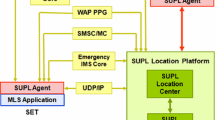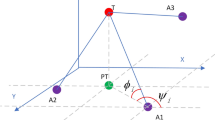Abstract
Location information is attracting more and more attention due to the increasing awareness of its importance for a wide range of applications. Whether it is for tracking valuable assets in the industrial context or monitoring the motion of elderly people and patients to prevent accidents or offering a better shopping experience using proximity and positioning marketing, an accurate and efficient indoor positioning has become crucial. Aware of this increasing need, we present in this paper “EIPSO” a new indoor 3D positioning algorithm based on Game Theory. An emphasis has been put on the energy efficiency of the proposed solution using “mGAPS” a hybrid micro-genetic and pattern search optimization process to reach the Nash equilibrium. A series of real experiments using Zigbee technology have been conducted on a testbed in LaRINa laboratory at the University of Carthage to evaluate the performances of the proposed solution. The obtained results prove the dynamic behavior of EIPSO which adapts the transmit power to both the signal quality and the battery level of the considered nodes. Moreover, a significant improvement of more than 40% of the network lifetime has been observed when using EIPSO while maintaining the positioning accuracy at a high level (≥ 90%).













Similar content being viewed by others
References
Idoudi M, Bourennane E-B, Grayaa K (2018) Wireless visual sensor network platform for indoor localization and tracking of a patient for rehabilitation task. IEEE Sens J 18(14):5915–5928
Kuflik T, Lanir J, Dim E, Wecker A, Corra’ M, Zancanaro M, Stock O (2011) Indoor positioning: challenges and solutions for indoor cultural heritage sites. In Proceedings of the 15th international conference on Intelligent user interfaces - IUI ’11. the 15th international conference. ACM Press. https://doi.org/10.1145/1943403.1943469
Mahjri I, Dhraief A, Belghith A, Drira K, Mathkour H (2016) A GPS-less framework for localization and coverage maintenance in wireless sensor networks. KSII Trans Internet Inf Syst 10(1):96–116
Basiri A, Lohan ES, Moore T, Winstanley A, Peltola P, Hill C, Amirian P, Figueiredo e Silva P (2017) Indoor location based services challenges, requirements and usability of current solutions. In Computer Science Review 24:1–12. Elsevier BV. https://doi.org/10.1016/j.cosrev.2017.03.002
Zafari F, Gkelias A, Leung KK (2019) A survey of indoor localization systems and technologies. IEEE Commun Surv Tutorials 21(3):2568–2599
Oguntala G, Abd-Alhameed R, Jones S, Noras J, Patwary M, Rodriguez J (2018) Indoor location identification technologies for real-time IoT-based applications: An inclusive survey. In Computer Science Review 30:55–79. Elsevier BV. https://doi.org/10.1016/j.cosrev.2018.09.001
Sakperea W, Adeyeye-Oshinb M, Mlitwa NB (2017) A state-of-the-art survey of indoor positioning and navigation systems and technologies. SACJ 29(3):145–197
Yassin A, Nasser Y, Awad M, Al-Dubai A, Liu R, Yuen C, Raulefs R, Aboutanios E (2017) Recent Advances in Indoor Localization: A Survey on Theoretical Approaches and Applications. In IEEE Commun Surv Tutorials 19(2):1327–1346. https://doi.org/10.1109/comst.2016.2632427
Bisio I, Lavagetto F, Marchese M, Sciarrone A (2013) Energy efficient wifi-based fingerprinting for indoor positioning with smartphones. In: IEEE Global Communication Conference (GlobeCom'13)
Abdellatif M, Mtibaa A, Harras KA, Youssef M (2013) GreenLoc: an energy efficient architecture for WiFi-based indoor localization on mobile phones. In 2013 IEEE International Conference on Communications ICC. https://doi.org/10.1109/icc.2013.6655263
He S, Chan S-HG (2016) Wi-Fi fingerprint-based indoor positioning: recent advances and comparisons. IEEE Commun Surv Tutorials 18(1):466–490
Sadowski S, Spachos P (2018) RSSI-based indoor localization with the internet of things. In IEEE access 6:30149–30161. Institute of electrical and electronics engineers (IEEE). https://doi.org/10.1109/access.2018.2843325
Abane A, Daoui M, Bouzefrane S, Muhlethaler P (2019) NDN-over-ZigBee: a ZigBee support for named data networking. In future generation computer systems 93:792–798. Elsevier BV. https://doi.org/10.1016/j.future.2017.09.053
Yang C-T, Chen S-T, Den W, Wang Y-T, Kristiani E (2018) Implementation of an intelligent indoor environmental monitoring and management system in cloud. Futur Gener Comput Syst 96:731–749
Kouroshnezhad S, Peiravi A, Sayad Haghighi M, Zhang Q (2019) A mixed-integer linear programming approach for energy-constrained mobile anchor path planning in wireless sensor networks localization. In Ad Hoc Networks 87:188–199. Elsevier BV. https://doi.org/10.1016/j.adhoc.2018.12.014
Guidara A, Derbel F, Fersi G, Bdiri S, Jemaa MB (2019) Energy-efficient on-demand indoor localization platform based on wireless sensor networks using low power wake up receiver. In Ad Hoc Networks (93):101902. Elsevier BV. https://doi.org/10.1016/j.adhoc.2019.101902
Abdal-Kadhim AM, Leong KS (2020) Event Priority Driven Dissemination EPDD management algorithm for low power WSN nodes powered by a dual source energy harvester. In AEU - Int J Electron Commun 113:152988. Elsevier BV. https://doi.org/10.1016/j.aeue.2019.152988
Wang Y, Chen H, Wu X, Shu L (2016) An energy-efficient SDN based sleep scheduling algorithm for WSNs. J Netw Comput Appl 59:39–45
Zhang Y, Feng C-H, Demirkol I, Heinzelman W (2010) Energy-efficient duty cycle assignment for receiver-based convergecast in wireless sensor networks. In: IEEE Global Telecommunications Conference (GLOBECOM 2010)
Suganya SS, Padmaja D, Latha YS (2016) Optimization and lifetime anticipation for WSN using fuzz logic. In 2016 International Conference on Electrical, Electronics, and Optimization Techniques (ICEEOT)
Farzinvash L, Najjar-Ghabel S, Javadzadeh T (2019) A distributed and energy-efficient approach for collecting emergency data in wireless sensor networks with mobile sinks. AEU-Int J Electron C 108:79–86
Prithi S, Sumathi S (2020) LD2FA-PSO: a novel learning dynamic deterministic finite automata with pso algorithm for secured energy efficient routing in wireless sensor network. In Ad Hoc Networks 97:102024. Elsevier BV. https://doi.org/10.1016/j.adhoc.2019.102024
Wang J, Cao J, Ji S, Park J (2017) Energy-efficient cluster-based dynamic routes adjustment approach for wireless sensor networks with mobile sinks. J Supercomput 73(7):3277–3290
Fersi G, Louati W, Jemaa M (2016) Clever: cluster-based energy-aware virtual ring routing in randomly deployed wireless sensor networks. Peer-to-Peer Netw Appl 9(4):640–655
Phan DD, Moulay E, Coirault P, Poussard AM, Vauzelle R (2015) Potential feedback control for the power control in wireless sensor networks. IET Control Theory Appl 9(13):2022–2028
Belgana A, Rimal BP, Maier M (2014) Multi-Objective Pricing Game Among Interconnected Smart Microgrids, in 2014 IEEE PES General Meeting | Conference & Exposition, National Harbor, MD
Han Z, Niyato D, Saad W, Basar T, Hjørungnes A (2012) Game Theory in Wireless and Communication Networks Theory, Models, and Applications. Cambridge University Press
Hakimi SM, Hasankhani A (2020) Intelligent energy management in off-grid smart buildings with energy interaction. In J Clean Prod 244:118906. Elsevier BV. https://doi.org/10.1016/j.jclepro.2019.118906
Carbonell-Nicolau, O., McLean, R. P. (2014). Refinements of Nash equilibrium in potential games. In Theor Econ 9(3):555–582. The Econometric Society. https://doi.org/10.3982/te1178
Maddouri M, Debbiche A, Elkhorchani H, Grayaa K (2018) Game Theory and Hybrid Genetic Algorithm for Energy Management and Real Time Pricing in Smart Grid," in 3rd CISTEM’18, Algiers, Algeria
Xiang P, Ji P, Zhang D (2018) Enhance RSS-Based Indoor Localization Accuracy by Leveraging Environmental Physical Features. Wireless Communications and Mobile Computing, vol. 2018, no. Special issue Advances in Infrastructure Mobility for Future Networks
Author information
Authors and Affiliations
Corresponding author
Additional information
Publisher's note
Springer Nature remains neutral with regard to jurisdictional claims in published maps and institutional affiliations.
Rights and permissions
Springer Nature or its licensor holds exclusive rights to this article under a publishing agreement with the author(s) or other rightsholder(s); author self-archiving of the accepted manuscript version of this article is solely governed by the terms of such publishing agreement and applicable law.
About this article
Cite this article
Debbiche, A., Msadaa, I.C. & Grayaa, K. EIPSO: An Energy Efficient Indoor Positioning System based on Game Theory. Mobile Netw Appl 28, 85–96 (2023). https://doi.org/10.1007/s11036-022-02041-2
Accepted:
Published:
Issue Date:
DOI: https://doi.org/10.1007/s11036-022-02041-2




